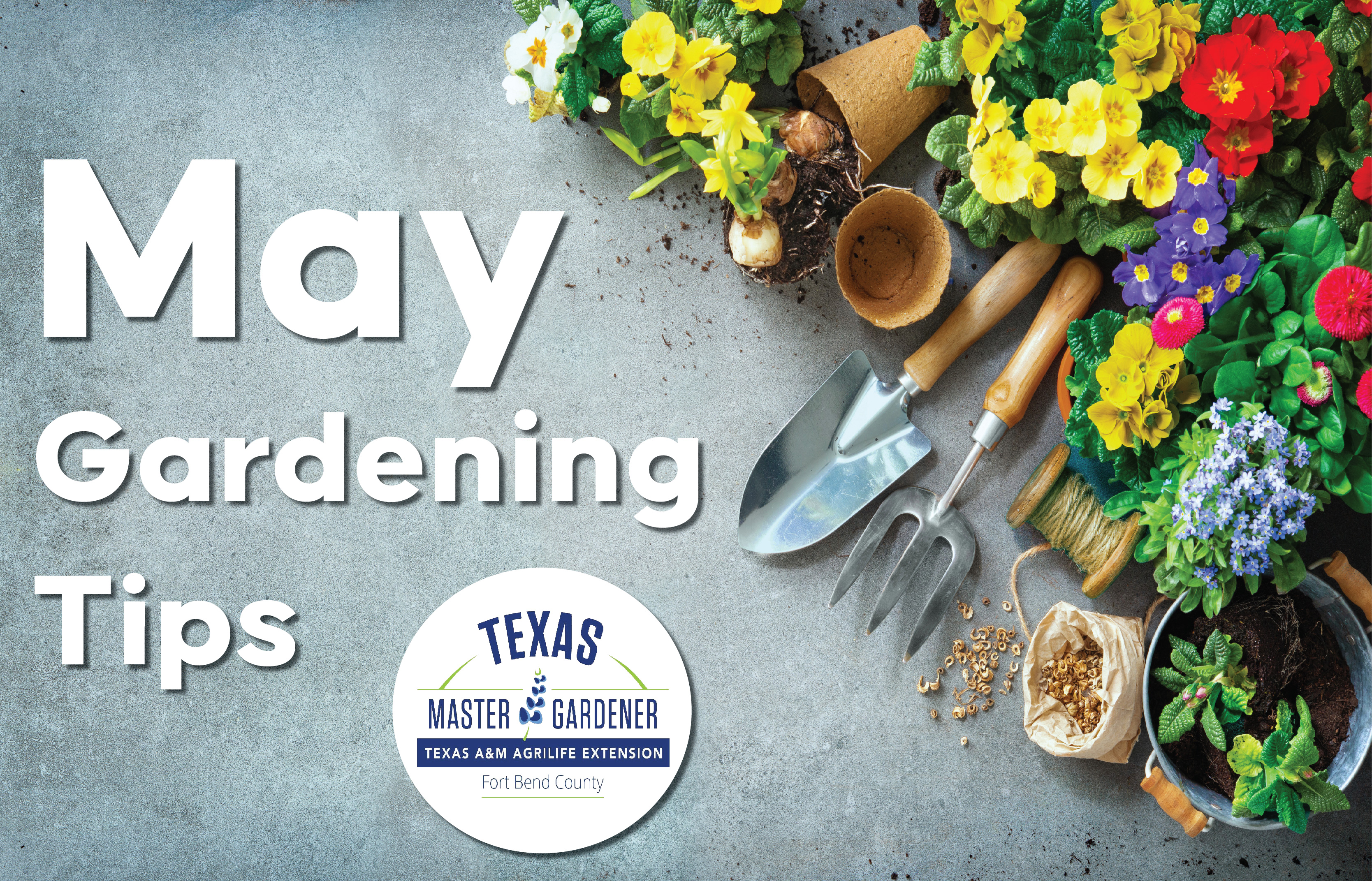
Fort Bend County Master Gardeners Shares Top Gardening Tips for May
This information has been generously provided to Fort Bend County residents free of charge by the Fort Bend County Master Gardeners, an expert group of trained volunteers assisting Texas A&M AgriLife Extension Service in educating the community using research-based horticultural information.
Did you know that the Fort Bend County Master Gardeners offer free training, events and other resources all year round? To learn more, visit fbmg.org.
Gardens can be such a source of peace and tranquility, especially at this time of the year when the weather is so lovely. Fort Bend Master Gardeners hope you get to spend some time in a beautiful garden near you. If you are working in yours, here are some suggested tasks.
May Gardening Tasks in Fort Bend County
-
Your garden might be attracting bugs but don’t rush for the insecticides! Some insects are beneficial to your garden and we are not just talking about bees. Lady beetles eat aphids, dragonflies eat mosquitoes, and other beneficial insects really help you in your garden. Learn about beneficial insects so you can identify, attract, and protect them.
-
As the weather warms up, check your irrigation system to make sure it is watering 1⁄2 to 1 inches of water per week when it doesn’t rain.
-
As the weather warms, you can now plant some of your summer vegetables such as okra, cantaloupe, eggplant, watermelon, Southern peas, sweet potatoes, and pumpkins. You will be glad you did when you are enjoying homemade gumbo and pumpkin pies. Learn about some easy vegetables to grow from Texas A&M.
-
Are your herbs getting too large? Prune them gently (learn how to grow and prune herbs) and then use them in your cooking, share them, or dry them for use later.
-
Roses are heavy feeders. If you haven’t fertilized them lately, they should be fertilized after their spring pruning to keep them healthy. Learn more about rose care and fertilization.
-
Like roses, tomatoes are heavy feeders and need to be regularly watered and fertilized. Learn more about growing tomatoes.
-
Vegetables and established berries, like blueberries and blackberries, need to be watered about twice per week but your best guide is your fingers. Dig down a few inches (8-10 inches for berries) and feel if the soil is moist. If not, it is time to water. Learn about vegetable watering.
-
Now is the time to plant some heat-tolerant perennials to liven up your landscape. Make sure they get adequate water while they establish their new root system. For inspiration, read about perennial plants for South Texas.
-
Also, you can still add sod to the bare spots in your lawn. Do it now before the summer heat makes it harder to transplant or seed new grass. However, before you do that, you determine what is causing these bare spots.
-
Clean up your spring bloomers by trimming off dead flowers and stems to make your garden look neater. If the foliage has turned yellow or brown, you can trim that too. Learn how to prune spring bloomers.
-
Do you know the correct mowing height for your type of grass? Cutting too much can harm your grass making it more vulnerable to disease.
-
Carry a camera or your cell phone into the garden while you work. That way you can snap photos of any problems or pests you see. Then, if you need help researching the problem, you can send the photo to your friendly Master Gardener Hotline. This free service will give you science-based answers to your horticultural problems. Find their contact information at fbmg.org/ask-a-master-gardener.
-
Controlling weeds is not glamorous but it is a necessary part of maintaining your landscape. Mulch is a great weed deterrent. Learn about an integrated approach to weed management in your landscape beds.
-
The right landscaping can protect your home from weather conditions making your heating and cooling more efficient and save money ($$$$$!). Put in this landscaping now before it is too hot to do this work.
-
You might have noticed a place in your garden that gets a bit swampy. This might be a great place to put in a rain garden. Although many plants require well drained soil, some do very well in wetter areas. Learn about putting in a rain garden.
-
Have a safe and thankful Memorial Day! Memorial Day is a day to honor those who gave their lives in war. Perhaps you will want to plant flowers at a grave or wear a poppy, the symbolic flower of remembrance.
May Color in Fort Bend County
Let’s start with our Texas Superstar® of the Month: Blue Princess Verbena (Glandularia x hybrida ‘Blue Princess’). This hardy perennial blooms from late spring through late fall and attracts butterflies and hummingbirds with its lavender blue blossoms. A slightly different variety, called Rose Princess, is also available with pink blossoms.
This easy-care plant will make a great addition to the front of your gardens where it can grow to a height of about 1 foot. It can also be grown in planters. For more information about this plant, visit texassuperstar.com/blue-princess-verbena.
For more information about Texas Superstar plants, visit texassuperstar.com.
Here are some other blooms to brighten your May. We hope you find space for some of these in your garden.
-
Blue Daze (Evolvulus nuttallianus): This recent addition to the list of Texas Superstars has blue flowers and does well in both heat and sun. It is an annual. Plant it in full sun where it will grow to 9 – 18 inches tall.
-
Giant Turk’s Cap or Turk’s Cap (Malvaviscus drummondii): This hardy deciduous perennial will grow to a height of 7 to 9 feet (Giant) or 3 to 7 feet (standard size) and a width of 3 to 4 feet with red drooping blooms that look like little Turkish caps. (Occasionally, you can find one with white blooms.) It grows well in full or part sun but has more blooms in full sun.
-
Yellow Bells or Esperanza (Tecoma stans): Yellow Bells is a Texas native that explodes with a riot of yellow flowers from spring to frost. It is a perennial shrub with an irregular growth pattern. There is also a variety, called Gold Star Esperanza, that is a Texas Superstar®.
-
Purslane (Portulaca oleracea): A tropical groundcover that can be a perennial in tropical climates, it is considered an annual in most parts of Texas. It can be found with blooms in many different colors, including bi-colors and mixed colors, and grows well in full sun or part sun.
-
Bougainvillea (Bougainvillea spectabilis): Although it is a tropical shrub, this crazy plant does not know when to not bloom. You can count on flowers year around with this perennial when winters are mild. It grows well in full or part sun and can be trimmed vigorously if needed. Blossoms come in many colors to match any garden scheme but be careful of its thorns.
Want to go deeper? Visit the Fort Bend County Master Gardeners' Article Library for a plethora of information about gardening in your region at fbmg.org/fort-bend-gardening/article-library. Contact the Fort Bend County Master Gardeners help desk at fbmg.org/ask-a-master-gardener for assistance with your horticultural needs.










